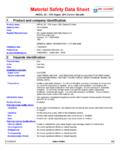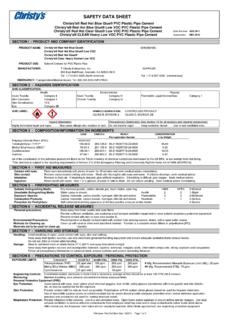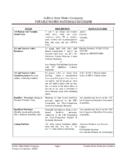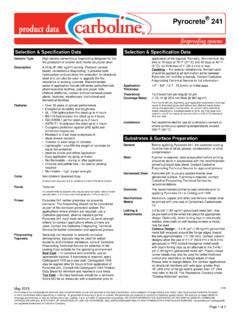Transcription of CHEMTREC Transportation Material Safety Data Sheet
1 CHEMTREC Transportation Emergency Phone: 800- Material 424-9300. Pittsburgh Poison Control Safety Data Center Health Emergency No.: 412- 681-6669. Sheet NOTE: The CHEMTREC Transportation Emergency Phone is to be used only in the event of chemical emergencies involving a spill, leak, fire, exposure or accident involving chemicals Section 1 - Chemical Product / Company Information Revision Product Name: BITUMASTIC 300 M PART A 12/21/2010. Date: Identification PLMSDS 0165A5NL Supercedes : 03/25/2008. Number: Product Coal Tar Epoxy - FOR.
2 Use/Class: INDUSTRIAL USE ONLY. Preparer: Regulatory, Department Manufacturer: Carboline Company 2150 Schuetz Road St. Louis, MO 63146. (800) 848-4645. Section 2 - Composition / Information On Ingredients Chemical Name CAS Number Weight % Less Than ACGIH TLV-TWA ACGIH TLV-STEL OSHA PEL-TWAOSHA-CEIL. COAL TAR FIBER PITCH 65996-93-2 MGM3 N/E MGM3 NE. TALC 14807-96-6 N/E N/E N/E N/E. POLYAMIDE 68082-29-1 NE NE NE NE. META-XYLENE 108-38-3 434 Mg/M3 651 Mg/M3 434 Mg/M3 N/E. PARA-XYLENE 106-42-3 100 PPM 150 PPM 435 MGM3 N/E. ETHYL BENZENE 100-41-4 100 PPM 125 PPM 435 MGM3 N/E.
3 ORTHO-XYLENE 95-47-6 434 Mg/M3 651 Mg/M3 434 Mg/M3 N/E. CLAY TRADE SECRET NE NE NE NE. ETHYL ALCOHOL 64-17-5 1000 PPM 1000 PPM 1900 MGM3 N/E. CLAY 68911-87-5 NE NE NE NE. TRIS-2,4,6- 90-72-2 NE N/E NE NE. (DIMETHYLAMINOMETHYL). PHENOL. MICROCRYSTALLINE 14808-60-7 MG/M3 N/E MG/M3 N/E. SILICA (respirable) (respirable). TOLUENE 108-88-3 20 PPM N/E 375 MGM3 NE. Section 3 - Hazards Identification Emergency Overview: Warning! Flammable. Harmful if inhaled. Causes eye and skin irritation. Aspiration may cause lung damage. May cause dizziness and drowsiness.
4 Keep away from heat, sparks, flame. Avoid breathing vapor. Avoid contact with eyes, skin and clothing. Do not swallow. Keep container closed. Use with adequate ventilation. Wash thoroughly after handling. Contains SILICA which can cause cancer. Contains COAL TAR which can cause cancer. Contains AROMATIC DISTILLATE whcih can cause cancer. Risk of Cancer depends on duration and level of exposure. Effects Of Overexposure - Eye Contact: Can cause eye burns. Effects Of Overexposure - Skin Contact: May cause allergic skin reaction.
5 Can cause skin burns. Effects Of Overexposure - Inhalation: Harmful if inhaled, may affect the brain or nervous system, causing dizziness, headache, or nausea. May cause nose and throat irritation. May cause lung irritation. May cause allergic respiratory reaction, effects may be permanent. Effects Of Overexposure - Ingestion: Harmful if swallowed. Page 1 of 5. Effects Of Overexposure - Chronic Hazards: Crystalline silica is known to cause silicosis. Crystalline silica (Quartz) is classified as a known human carcinogen (Group 1) by IARC.
6 Exposure is by route of inhalation. If Material is in a liquid matrix it is unlikely to be inhaled. However, when sanding or grinding the finished product, there may be potential for crystalline silica to become airborne. Reports have associated repeated and prolonged occupational overexposure to solvents with permanent brain and nervous system damage. Primary Route(s) Of Entry: Skin Contact, Skin Absorption, Inhalation, Ingestion, Eye Contact Medical Conditions Prone to Aggravation by Exposure: If sensitized to amines, epoxies, or other chemicals do not use.
7 See a physician if a medical condition exists. If you have a condition that could be aggravated by exposure to dust or organic vapors, see a physician prior to use. Section 4 - First Aid Measures First Aid - Eye Contact: If Material gets into eyes, flush with water immediately for 15 minutes. Consult a physician. First Aid - Skin Contact: In case of contact, immediately flush skin with plenty of water while removing contaminated clothing and shoes. Launder clothing before reuse. If rash or irritation develops, consult a physician.
8 First Aid - Inhalation: If inhaled, remove to fresh air. Administer oxygen if necessary. Consult a physician if symptoms persist or exposure was severe. First Aid - Ingestion: If swallowed do not induce vomiting. Seek immediate medical attention. Section 5 - Fire Fighting Measures Flash Point, F: 75F (23C) Lower Explosive Limit, %: (Setaflash) Upper Explosive Limit, %: Extinguishing Media: Carbon Dioxide, Dry Chemical, Foam, Water Fog Unusual Fire And Explosion Hazards: Flammable Liquid. Vapors are heavier than air and will accumulate.
9 Vapors will form explosive concentrations with air. Vapors travel long distances and will flashback. Use mechanical ventilation when necessary to keep percent vapor below the "Lower Explosion Level" (LEL). Eliminate all ignition sources. Keep away from sparks, open flames and heat sources. All electric equipment and installations should be made and grounded in accordance with the National Electrical Code. In areas where explosion hazards exist, workers should be required to use non-ferrous tools and to wear conductive and non-sparking shoes.
10 Special Firefighting Procedures: Flammable. Cool fire-exposed containers using water spray. Section 6 - Accidental Release Measures Steps To Be Taken If Material Is Released Or Spilled: Eliminate all ignition sources. Handling equipment must be grounded to prevent sparking. Evacuate the area of unprotected personnel. Wear appropriate personal protection clothing and equipment. Follow exposure controls/personal protection guidelines in Section 8. Contain and soak up residual with an aborbent (clay or sand). Take up absorbant Material and seal tightly for proper disposal.







